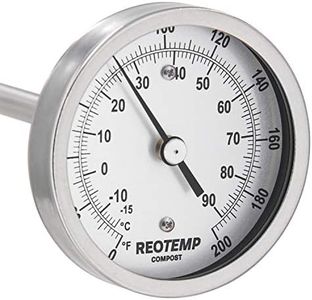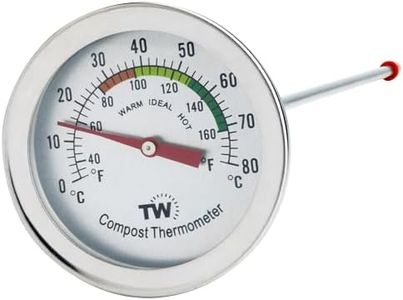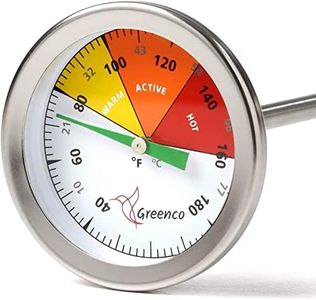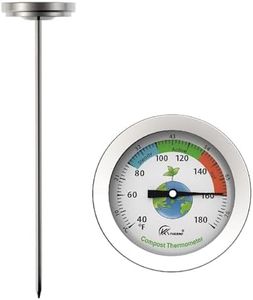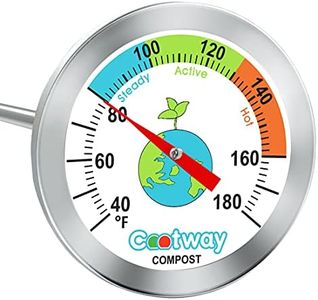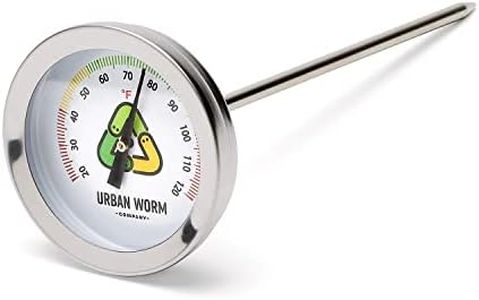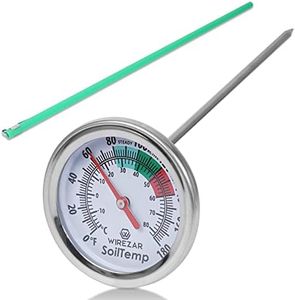We Use CookiesWe use cookies to enhance the security, performance,
functionality and for analytical and promotional activities. By continuing to browse this site you
are agreeing to our privacy policy
10 Best Compost Thermometers
From leading brands and best sellers available on the web.Buying Guide for the Best Compost Thermometers
Choosing a compost thermometer may seem simple, but it’s worth knowing a bit more to pick the best tool for your composting needs. A compost thermometer helps you monitor the temperature of your compost pile, which is important because good composting relies on keeping the pile within certain temperature ranges to encourage beneficial microbes and ensure safe decomposition. Paying attention to key features ensures accurate readings and a longer-lasting device.Probe LengthProbe length refers to how long the metal stem of the thermometer is, and it matters because it needs to reach the center of your compost pile, where heat is most intense. Short probes (around 12 inches) are best for smaller compost bins or piles, while medium lengths (18-20 inches) suit typical garden compost heaps. Extra-long probes (24 inches and above) are ideal if you have very large or deep piles. To pick the right one, think about the size and depth of your pile—make sure the probe can comfortably reach the middle for the most accurate reading.
Temperature RangeTemperature range refers to the lowest and highest temperatures that the thermometer can measure. Compost piles can vary widely in temperature, from cool ambient conditions up to around 200°F (93°C) during their hottest phase. A thermometer that covers roughly 0°F to 200°F (or -20°C to 100°C) is usually more than enough. Choose a thermometer with a range that covers the typical temperatures your compost reaches—too narrow and you might miss important information, too wide and the scale may be harder to read accurately for the active composting zone.
Display TypeDisplay type means whether the thermometer shows temperature with a dial (analog) or digitally. Analog dials are simple, durable, and don’t require batteries, working well outdoors. Digital displays can be easier to read, especially if you have difficulty reading small numbers, but they may need batteries and can be more sensitive to wet or rough conditions. Pick the type that matches your preference for readability and maintenance; analog is a safe bet for most users.
Water and Corrosion ResistanceA compost thermometer is often exposed to moisture, heat, and organic acids in the pile. Water and corrosion resistance describes how well the materials hold up to these conditions. Stainless steel is a common corrosion-resistant material and lasts longer in the wet, acidic environment of compost. Try to choose a thermometer that specifically mentions water or rust resistance to ensure it won’t break down after a few uses.
Calibration FeatureCalibration is the ability to adjust the reading of your thermometer if it drifts over time. This feature allows you to reset the thermometer to show the correct temperature, ensuring your measurements stay accurate. Thermometers without calibration can become less reliable as they age. If you’ll be relying heavily on temperature readings for precise compost management, a model with easy calibration is a good choice.
Durability and Build QualityBecause compost piles can be dense and even packed with sticks or other rough materials, the overall build quality and sturdiness of the thermometer matter. Look for a solid connection between the probe and display, and a tough, bend-resistant stem. A flimsy thermometer could bend or break in the pile, so check for reviews or descriptions mentioning durability if you often turn your pile or compost materials are tough.
